Free d-Amino Acids in Salivary Gland in Rat
Abstract
Simple Summary
Abstract
1. Introduction
2. Materials and Methods
2.1. Animals
2.2. Chemicals
2.3. Sample Tissue Preparation
2.4. Determination of Amino Acid Enantiomers by 2D-HPLC
2.5. Real Time-Quantitative Reverse Transcriptase-Polymerase Chain Reaction (RT-PCR)
2.6. Capillary Electrophoresis-Based Immunodetection Assay (Simple Western)
2.7. Statistical Analyses
3. Results
3.1. Determination of Amino Acid Enantiomers in Rat Salivary Glands Tissues Using 2D-HPLC
3.2. Gene Expression of Serine Racemase, DAO, and DDO in Three Major Salivary Glands
3.3. Protein Expression of Serine Racemase, DAO, and DDO in Three Major Salivary Glands
3.4. Gene Expression of NMDA Receptor Subunits in Three Major Salivary Glands
3.5. Protein Expression of NR1 and NR2D in Three Major Salivary Glands
4. Discussion
5. Conclusions
Author Contributions
Funding
Institutional Review Board Statement
Informed Consent Statement
Data Availability Statement
Acknowledgments
Conflicts of Interest
References
- Pollegioni, L.; Rosini, E.; Molla, G. Advances in Enzymatic Synthesis of D-Amino Acids. Int. J. Mol. Sci. 2020, 21, 3206. [Google Scholar] [CrossRef] [PubMed]
- Hashimoto, A.; Oka, T. Free D-aspartate and D-serine in the mammalian brain and periphery. Prog. Neurobiol. 1997, 52, 325–353. [Google Scholar] [CrossRef]
- Konno, H.B.R.; D’Aniello, A.; Fisher, G.; Fujii, N.; Homma, H. (Eds.) D-Amino Acids: A New Frontier in Amino Acids and Protein Research–Practical Methods and Protocols; Nova Science Publishers: New York, NY, USA, 2007. [Google Scholar]
- Fuchs, S.A.; Berger, R.; Klomp, L.W.J.; de Koning, T.J. D-Amino acids in the central nervous system in health and disease. Mol. Genet. Metab. 2005, 85, 168–180. [Google Scholar] [CrossRef] [PubMed]
- Hamase, K.; Morikawa, A.; Zaitsu, K. D-Amino acids in mammals and their diagnostic value. J. Chromatogr. B 2002, 781, 73–91. [Google Scholar] [CrossRef]
- Hashimoto, A.; Yoshikawa, M. Effect of aminooxyacetic acid on extracellular level of D-serine in rat striatum: An in vivo microdialysis study. Eur. J. Pharmacol. 2005, 525, 91–93. [Google Scholar] [CrossRef]
- Hashimoto, A.; Nishikawa, T.; Oka, T.; Takahashi, K.; Hayashi, T. Determination of free amino acid enantiomers in rat brain and serum by high-performance liquid chromatography after derivatization with N-tert.-butyloxycarbonyl-L-cysteine and o-phthaldialdehyde. J. Chromatogr. B Biomed. Sci. Appl. 1992, 582, 41–48. [Google Scholar] [CrossRef]
- Wolosker, H.; Dumin, E.; Balan, L.; Foltyn, V.N. D-Amino acids in the brain: D-serine in neurotransmission and neurodegeneration. FEBS J. 2008, 275, 3514–3526. [Google Scholar] [CrossRef]
- Mothet, J.-P.; Parent, A.l.T.; Wolosker, H.; Brady, R.O.; Linden, D.J.; Ferris, C.D.; Rogawski, M.A.; Snyder, S.H. D-Serine is an endogenous ligand for the glycine site of the N-methyl-D-aspartate receptor. Proc. Natl. Acad. Sci. USA 2000, 97, 4926–4931. [Google Scholar] [CrossRef]
- Hashimoto, A.; Oka, T.; Nishikawa, T. Extracellular concentration of endogenous free D-serine in the rat brain as revealed by in vivo microdialysis. Neuroscience 1995, 66, 635–643. [Google Scholar] [CrossRef]
- Balu, D.T. The NMDA Receptor and Schizophrenia: From Pathophysiology to Treatment. Adv. Pharmacol. 2016, 76, 351–382. [Google Scholar]
- Hashimoto, K. The NMDA receptor hypofunction hypothesis for schizophrenia and glycine modulatory sites on the NMDA receptors as potential therapeutic drugs. Clin. Psychopharmacol. Neurosci. 2006, 4, 3–10. [Google Scholar]
- Hashimoto, A.; Oka, T.; Nishikawa, T. Anatomical Distribution and Postnatal Changes in Endogenous Free D-Aspartate and D-Serine in Rat Brain and Periphery. Eur. J. Neurosci. 1995, 7, 1657–1663. [Google Scholar] [CrossRef]
- Dunlop, D.S.; Neidle, A.; McHale, D.; Dunlop, D.M.; Lajtha, A. The presence of free D-aspartic acid in rodents and man. Biochem. Biophys. Res. Commun. 1986, 141, 27–32. [Google Scholar] [CrossRef]
- Fagg, G.E.; Matus, A. Selective association of N-methyl-D-aspartate and quisqualate types of L-glutamate receptor with brain postsynaptic densities. Proc. Natl. Acad. Sci. USA 1984, 81, 6876–6880. [Google Scholar] [CrossRef] [PubMed]
- Imai, K.; Fukushima, T.; Hagiwara, K.; Santa, T. Occurrence of D-aspartic acid in rat brain pineal gland. Biomed. Chromatogr. 1995, 9, 106–109. [Google Scholar] [CrossRef]
- Hamase, K.; Homma, H.; Takigawa, Y.; Fukushima, T.; Santa, T.; Imai, K. Regional distribution and postnatal changes of D-amino acids in rat brain. Biochim. Biophys. Acta 1997, 1334, 214–222. [Google Scholar] [CrossRef]
- D’Aniello, A.; Cosmo, A.D.; Cristo, C.D.; Annunziato, L.; Petrucelli, L.; Fisher, G. Involvement of D-Aspartic acid in the synthesis of testosterone in rat testes. Life Sci. 1996, 59, 97–104. [Google Scholar] [CrossRef]
- D’Aniello, A.; Di Fiore, M.M.; Fisher, G.H.; Milone, A.; Seleni, A.; D’Aniello, S.; Perna, A.F.; Ingrosso, D. Occurrence of D-aspartic acid and N-methyl-D-aspartic acid in rat neuroendocrine tissues and their role in the modulation of luteinizing hormone and growth hormone release. FASEB J. 2000, 14, 699–714. [Google Scholar] [CrossRef]
- D’Aniello, G.; Tolino, A.; D’Aniello, A.; Errico, F.; Fisher, G.H.; Di Fiore, M.M. The Role of D-Aspartic Acid and N-Methyl-d-Aspartic Acid in the Regulation of Prolactin Release. Endocrinology 2000, 141, 3862–3870. [Google Scholar] [CrossRef]
- Ishio, S.; Yamada, H.; Hayashi, M.; Yatsushiro, S.; Noumi, T.; Yamaguchi, A.; Moriyama, Y. d-Aspartate modulates melatonin synthesis in rat pinealocytes. Neurosci. Lett. 1998, 249, 143–146. [Google Scholar] [CrossRef]
- Long, Z.; Lee, J.-A.; Okamoto, T.; Nimura, N.; Imai, K.; Homma, H. D-Aspartate in a Prolactin-Secreting Clonal Strain of Rat Pituitary Tumor Cells (GH3). Biochem. Biophys. Res. Commun. 2000, 276, 1143–1147. [Google Scholar] [CrossRef] [PubMed]
- Monteforte, R.; Santillo, A.; Di Giovanni, M.; D’Aniello, A.; Di Maro, A.; Chieffi Baccari, G. D-Aspartate affects secretory activity in rat Harderian gland: Molecular mechanism and functional significance. Amino Acids 2008, 37, 653. [Google Scholar] [CrossRef]
- Nagata, Y.; Homma, H.; Lee, J.-A.; Imai, K. D-Aspartate stimulation of testosterone synthesis in rat Leydig cells. FEBS Lett. 1999, 444, 160–164. [Google Scholar] [CrossRef]
- Homma, H. Biochemistry of D-aspartate in mammalian cells. Amino Acids 2007, 32, 3–11. [Google Scholar] [CrossRef]
- Karakawa, S.; Shimbo, K.; Yamada, N.; Mizukoshi, T.; Miyano, H.; Mita, M.; Lindner, W.; Hamase, K. Simultaneous analysis of D-alanine, D-aspartic acid, and D-serine using chiral high-performance liquid chromatography-tandem mass spectrometry and its application to the rat plasma and tissues. J. Pharm. Biomed. Anal. 2015, 115, 123–129. [Google Scholar] [CrossRef]
- Ota, N.; Shi, T.; Sweedler, J.V. D-Aspartate acts as a signaling molecule in nervous and neuroendocrine systems. Amino Acids 2012, 43, 1873–1886. [Google Scholar] [CrossRef] [PubMed]
- Wolosker, H.; Sheth, K.N.; Takahashi, M.; Mothet, J.-P.; Brady, R.O.; Ferris, C.D.; Snyder, S.H. Purification of serine racemase: Biosynthesis of the neuromodulator D-serine. Proc. Natl. Acad. Sci. USA 1999, 96, 721–725. [Google Scholar] [CrossRef]
- Ito, T.; Hayashida, M.; Kobayashi, S.; Muto, N.; Hayashi, A.; Yoshimura, T.; Mori, H. Serine racemase is involved in D-aspartate biosynthesis. J. Biochem. 2016, 160, 345–353. [Google Scholar] [CrossRef]
- Marcone, G.L.; Rosini, E.; Crespi, E.; Pollegioni, L. D-amino acids in foods. Appl. Microbiol. Biotechnol. 2020, 104, 555–574. [Google Scholar] [CrossRef]
- Genchi, G. An overview on D-amino acids. Amino Acids 2017, 49, 1521–1533. [Google Scholar] [CrossRef]
- Pollegioni, L.; Piubelli, L.; Sacchi, S.; Pilone, M.S.; Molla, G. Physiological functions of D-amino acid oxidases: From yeast to humans. Cell. Mol. Life Sci. 2007, 64, 1373–1394. [Google Scholar] [CrossRef] [PubMed]
- Koga, R.; Miyoshi, Y.; Sakaue, H.; Hamase, K.; Konno, R. Mouse D-Amino-Acid Oxidase: Distribution and Physiological Substrates. Front. Mol. Biosci. 2017, 4, 82. [Google Scholar] [CrossRef]
- Miyoshi, Y.; Hamase, K.; Tojo, Y.; Mita, M.; Konno, R.; Zaitsu, K. Determination of D-serine and D-alanine in the tissues and physiological fluids of mice with various D-amino-acid oxidase activities using two-dimensional high-performance liquid chromatography with fluorescence detection. J. Chromatogr. B 2009, 877, 2506–2512. [Google Scholar] [CrossRef] [PubMed]
- Molla, G.; Chaves-Sanjuan, A.; Savinelli, A.; Nardini, M.; Pollegioni, L. Structure and kinetic properties of human D-aspartate oxidase, the enzyme-controlling D-aspartate levels in brain. FASEB J. 2020, 34, 1182–1197. [Google Scholar] [CrossRef] [PubMed]
- Schell, M.J.; Cooper, O.B.; Snyder, S.H. D-aspartate localizations imply neuronal and neuroendocrine roles. Proc. Natl. Acad. Sci. USA 1997, 94, 2013–2018. [Google Scholar] [CrossRef]
- Etoh, S.; Hamase, K.; Morikawa, A.; Ohgusu, T.; Zaitsu, K. Enantioselective visualization of D-alanine in rat anterior pituitary gland: Localization to ACTH-secreting cells. Anal. Bioanal. Chem. 2009, 393, 217–223. [Google Scholar] [CrossRef]
- Morikawa, A.; Hamase, K.; Ohgusu, T.; Etoh, S.; Tanaka, H.; Koshiishi, I.; Shoyama, Y.; Zaitsu, K. Immunohistochemical localization of D-alanine to beta-cells in rat pancreas. Biochem. Biophys. Res. Commun. 2007, 355, 872–876. [Google Scholar] [CrossRef]
- Morikawa, A.; Hamase, K.; Zaitsu, K. Determination of D-alanine in the rat central nervous system and periphery using column-switching high-performance liquid chromatography. Anal. Biochem. 2003, 312, 66–72. [Google Scholar] [CrossRef]
- Morikawa, A.; Hamase, K.; Inoue, T.; Konno, R.; Niwa, A.; Zaitsu, K. Determination of free D-aspartic acid, D-serine and D-alanine in the brain of mutant mice lacking d-amino-acid oxidase activity. J. Chromatogr. B Biomed. Sci. Appl. 2001, 757, 119–125. [Google Scholar] [CrossRef]
- Monyer, H.; Sprengel, R.; Schoepfer, R.; Herb, A.; Higuchi, M.; Lomeli, H.; Burnashev, N.; Sakmann, B. and Seeburg, P.H. Heteromeric NMDA receptors: Molecular and functional distinction of subtypes. Science 1992, 256, 1217–1221. [Google Scholar] [CrossRef]
- Moriyoshi, K.; Masu, M.; Ishii, T.; Shigemoto, R.; Mizuno, N. and Nakanishi, S. Molecular cloning and characterization of the rat NMDA receptor. Nature 1991, 354, 31–37. [Google Scholar] [CrossRef] [PubMed]
- González, M.P.; Herrero, M.T.; Vicente, S.; Oset-Gasque, M.J. Effect of Glutamate Receptor Agonists on Catecholamine Secretion in Bovine Chromaffin Cells. Neuroendocrinology 1998, 67, 181–189. [Google Scholar] [CrossRef] [PubMed]
- Itzstein, C.; Espinosa, L.; Delmas, P.D.; Chenu, C. Specific Antagonists of NMDA Receptors Prevent Osteoclast Sealing Zone Formation Required for Bone Resorption. Biochem. Biophys. Res. Commun. 2000, 268, 201–209. [Google Scholar] [CrossRef] [PubMed]
- Arora, S.; Kaur, T.; Kaur, A.; Singh, A.P. Glycine aggravates ischemia reperfusion-induced acute kidney injury through N-Methyl-D-Aspartate receptor activation in rats. Mol. Cell. Biochem. 2014, 393, 123–131. [Google Scholar] [CrossRef]
- Anderson, M.; Suh, J.M.; Kim, E.Y.; Dryer, S.E. Functional NMDA receptors with atypical properties are expressed in podocytes. Am. J. Physiol.-Cell Physiol. 2011, 300, C22–C32. [Google Scholar] [CrossRef]
- Inagaki, N.; Kuromi, H.; Gonoi, T.; Okamoto, Y.; Ishida, H.; Seino, Y.; Kaneko, T.; Iwanaga, T.; Seino, S. Expression and role of ionotropic glutamate receptors in pancreatic islet cells. FASEB J. 1995, 9, 686–691. [Google Scholar] [CrossRef]
- Molnar, E.; Varadi, A.; McIlhinney, R.A.; Ashcroft, S.J.H. Identification of functional ionotropic glutamate receptor proteins in pancreatic beta-cells and in islets of Langerhans. FEBS Lett. 1995, 371, 253–257. [Google Scholar]
- Parisi, E.; Bozic, M.; Ibarz, M.; Panizo, S.; Valcheva, P.; Coll, B.; Fernandez, E.; Valdivielso, J.M. Sustained activation of renal N-methyl-d-aspartate receptors decreases vitamin D synthesis: A possible role for glutamate on the onset of secondary HPT. Am. J. Physiol.-Endocrinol. Metab. 2010, 299, E825–E831. [Google Scholar] [CrossRef]
- Hamase, K.; Miyoshi, Y.; Ueno, K.; Han, H.; Hirano, J.; Morikawa, A.; Mita, M.; Kaneko, T.; Lindner, W.; Zaitsu, K. Simultaneous determination of hydrophilic amino acid enantiomers in mammalian tissues and physiological fluids applying a fully automated micro-two-dimensional high-performance liquid chromatographic concept. J. Chromatogr. A 2010, 1217, 1056–1062. [Google Scholar] [CrossRef]
- Yoshikawa, M.; Kobayashi, T.; Oka, T.; Kawaguchi, M.; Hashimoto, A. Distribution and MK-801-induced expression of serine racemase mRNA in rat brain by real-time quantitative PCR. Mol. Brain Res. 2004, 128, 90–94. [Google Scholar] [CrossRef]
- Yoshikawa, M.; Oka, T.; Kawaguchi, M.; Hashimoto, A. MK-801 upregulates the expression of D-amino acid oxidase mRNA in rat brain. Mol. Brain Res. 2004, 131, 141–144. [Google Scholar] [CrossRef]
- Grigsby, K.B.; Kovarik, C.M.; Rottinghaus, G.E.; Booth, F.W. High and low nightly running behavior associates with nucleus accumbens N-Methyl-d-aspartate receptor (NMDAR) NR1 subunit expression and NMDAR functional differences. Neurosci. Lett. 2018, 671, 50–55. [Google Scholar] [CrossRef] [PubMed]
- Yoshikawa, M.; Shinomiya, T.; Takayasu, N.; Tsukamoto, H.; Kawaguchi, M.; Kobayashi, H.; Oka, T.; Hashimoto, A. Long-Term Treatment With Morphine Increases the D-Serine Content in the Rat Brain by Regulating the mRNA and Protein Expressions of Serine Racemase and d-Amino Acid Oxidase. J. Pharmacol. Sci. 2008, 107, 270–276. [Google Scholar] [CrossRef] [PubMed]
- Samuni, Y. and Baum, B.J. Gene delivery in salivary glands: From the bench to the clinic. Biochim. Biophys. Acta (BBA)-Mol. Basis Dis. 2011, 1812, 1515–1521. [Google Scholar] [CrossRef]
- Takeuchi, T.; Takemoto, T.; Tani, T.; Miwa, T. Letter: Gastrin-like immunoreactivity in salivary gland and saliva. Lancet 1973, 2, 920. [Google Scholar] [CrossRef]
- Ishizaka, S.; Kimoto, M.; Tsujii, T. Parotin Subunit as a Potent Polyclonal B Cell Activator Binds to Newly Found Glycosylphosphatidylinositol (GPI)-Anchored Proteins on Human B Cell Surfaces. Cell. Immunol. 1994, 154, 430–439. [Google Scholar] [CrossRef]
- Leonora, J.; Stenman, R. Evidence Suggesting the Existence of a Hypothalamic-Parotid Gland Endocrine Axis. Endocrinology 1968, 83, 807–815. [Google Scholar] [CrossRef] [PubMed]
- Lawrence, A.M.; Tan, S.; Hojvat, S.; Kirsteins, L. Salivary gland hyperglycemic factor: An extrapancreatic source of glucagon-like material. Science 1977, 195, 70–72. [Google Scholar] [CrossRef]
- Nexo, E.; Olsen, P.S.; Poulsen, K. Exocrine and endocrine secretion of renin and epidermal growth factor from the mouse submandibular glands. Regul. Pept. 1984, 8, 327–334. [Google Scholar] [CrossRef]
- Murphy, R.A.; Saide, J.D.; Blanchard, M.H.; Young, M. Nerve growth factor in mouse serum and saliva: Role of the submandibular gland. Proc. Natl. Acad. Sci. USA 1977, 74, 2330–2333. [Google Scholar] [CrossRef]
- Rougeot, C.; Vienet, R.; Cardona, A.; Le Doledec, L.; Grognet, J.M.; Rougeon, F. Targets for SMR1-pentapeptide suggest a link between the circulating peptide and mineral transport. Am. J. Physiol. 1997, 273, R1309–R1320. [Google Scholar] [CrossRef] [PubMed]
- Kan, T.; Yoshikawa, M.; Watanabe, M.; Miura, M.; Ito, K.; Matsuda, M.; Iwao, K.; Kobayashi, H.; Suzuki, T.; Suzuki, T. Sialorphin Potentiates Effects of [Met5]Enkephalin without Toxicity by Action other than Peptidase Inhibition. J. Pharmacol. Exp. Ther. 2020, 375, 104–114. [Google Scholar] [CrossRef] [PubMed]
- Ieko, T.; Sasaki, H.; Maeda, N.; Fujiki, J.; Iwano, H.; Yokota, H. Analysis of Corticosterone and Testosterone Synthesis in Rat Salivary Gland Homogenates. Front. Endocrinol. 2019, 10, 479. [Google Scholar] [CrossRef] [PubMed]
- Klein, R.M. Acinar cell proliferation in the parotid and submandibular salivary glands of the neonatal rat. Cell Prolif. 1982, 15, 187–195. [Google Scholar] [CrossRef] [PubMed]
- Masuda, W.; Nouso, C.; Kitamura, C.; Terashita, M.; Noguchi, T. Free D-aspartic acid in rat salivary glands. Arch. Biochem. Biophys. 2003, 420, 46–54. [Google Scholar] [CrossRef]
- Han, H.; Miyoshi, Y.; Ueno, K.; Okamura, C.; Tojo, Y.; Mita, M.; Lindner, W.; Zaitsu, K.; Hamase, K. Simultaneous determination of D-aspartic acid and d-glutamic acid in rat tissues and physiological fluids using a multi-loop two-dimensional HPLC procedure. J. Chromatogr. B 2011, 879, 3196–3202. [Google Scholar] [CrossRef]
- Adachi, M.; Koyama, H.; Long, Z.; Sekine, M.; Furuchi, T.; Imai, K.; Nimura, N.; Shimamoto, K.; Nakajima, T.; Homma, H. l-Glutamate in the extracellular space regulates endogenous d-aspartate homeostasis in rat pheochromocytoma MPT1 cells. Arch. Biochem. Biophys. 2004, 424, 89–96. [Google Scholar] [CrossRef]
- Kanai, Y.; Clemencion, B.; Simonin, A.; Leuenberger, M.; Lochner, M.; Weisstanner, M.; Hediger, M.A. The SLC1 high-affinity glutamate and neutral amino acid transporter family. Mol. Asp. Med. 2013, 34, 108–120. [Google Scholar] [CrossRef]
- Berger, U.V.; Hediger, M.A. Distribution of the glutamate transporters GLT-1 (SLC1A2) and GLAST (SLC1A3) in peripheral organs. Anat. Embryol. 2006, 211, 595–606. [Google Scholar] [CrossRef]
- Imai, K.; Fukushima, T.; Santa, T.; Homma, H.; Sugihara, J.; Kodama, H.; Yoshikawa, M. Accumulation of Radioactivity in Rat Brain and Peripheral Tissues Including Salivary Gland after Intravenous Administration of 14C-D-aspartic Acid. Proc. Jpn. Acad. Ser. B 1997, 73, 48–52. [Google Scholar] [CrossRef][Green Version]
- Kera, Y.; Aoyama, H.; Matsumura, H.; Hasegawa, A.; Nagasaki, H.; Yamada, R.-H. Presence of free D-glutamate and D-aspartate in rat tissues. Biochim. Biophys. Acta (BBA)-Gen. Subj. 1995, 1243, 282–286. [Google Scholar] [CrossRef]
- Topo, E.; Soricelli, A.; D’Aniello, A.; Ronsini, S.; D’Aniello, G. The role and molecular mechanism of D-aspartic acid in the release and synthesis of LH and testosterone in humans and rats. Reprod. Biol. Endocrinol. 2009, 7, 120. [Google Scholar] [CrossRef] [PubMed]
- Lockridge, A.; Baumann, D.; Akhaphong, B.; Abrenica, A.; Miller, R.; Alejandro, E.U. Serine racemase is expressed in islets and contributes to the regulation of glucose homeostasis. Islets 2016, 8, 195–206. [Google Scholar] [CrossRef]
- Miyoshi, Y.; Hamase, K.; Okamura, T.; Konno, R.; Kasai, N.; Tojo, Y.; Zaitsu, K. Simultaneous two-dimensional HPLC determination of free D-serine and D-alanine in the brain and periphery of mutant rats lacking D-amino-acid oxidase. J. Chromatogr. B 2011, 879, 3184–3189. [Google Scholar] [CrossRef]
- Frattini, L.F.; Piubelli, L.; Sacchi, S.; Molla, G.; Pollegioni, L. Is rat an appropriate animal model to study the involvement of d-serine catabolism in schizophrenia? insights from characterization of D-amino acid oxidase. FEBS J. 2011, 278, 4362–4373. [Google Scholar] [CrossRef] [PubMed]
- dos Santos Fagundes, I.; Rotta, L.N.; Schweigert, I.D.; Valle, S.C.; de Oliveira, K.R.; Huth Krüger, A.; Souza, K.B.; Souza, D.O.; Perry, M.L.S. Glycine, Serine, and Leucine Metabolism in Different Regions of Rat Central Nervous System. Neurochem. Res. 2001, 26, 245–249. [Google Scholar] [CrossRef]
- Verleysdonk, S.; Martin, H.; Willker, W.; Leibfritz, D.; Hamprecht, B. Rapid uptake and degradation of glycine by astroglial cells in culture: Synthesis and release of serine and lactate. Glia 1999, 27, 239–248. [Google Scholar] [CrossRef]
- Kawai, N.; Bannai, M.; Seki, S.; Koizumi, T.; Shinkai, K.; Nagao, K.; Matsuzawa, D.; Takahashi, M.; Shimizu, E. Pharmacokinetics and cerebral distribution of glycine administered to rats. Amino Acids 2012, 42, 2129–2137. [Google Scholar] [CrossRef]
- Liu, L.; Wong, T.P.; Pozza, M.F.; Lingenhoehl, K.; Wang, Y.; Sheng, M.; Auberson, Y.P.; Wang, Y.T. Role of NMDA Receptor Subtypes in Governing the Direction of Hippocampal Synaptic Plasticity. Science 2004, 304, 1021–1024. [Google Scholar] [CrossRef]
- Massey, P.V.; Johnson, B.E.; Moult, P.R.; Auberson, Y.P.; Brown, M.W.; Molnar, E.; Collingridge, G.L.; Bashir, Z.I. Differential Roles of NR2A and NR2B-Containing NMDA Receptors in Cortical Long-Term Potentiation and Long-Term Depression. J. Neurosci. 2004, 24, 7821–7828. [Google Scholar] [CrossRef]
- Cull-Candy, S.; Brickley, S.; Farrant, M. NMDA receptor subunits: Diversity, development and disease. Curr. Opin. Neurobiol. 2001, 11, 327–335. [Google Scholar] [CrossRef]
- von Engelhardt, J.; Coserea, I.; Pawlak, V.; Fuchs, E.C.; Köhr, G.; Seeburg, P.H.; Monyer, H. Excitotoxicity in vitro by NR2A- and NR2B-containing NMDA receptors. Neuropharmacology 2007, 53, 10–17. [Google Scholar] [CrossRef] [PubMed]
- Wenzel, A.; Benke, D.; Mohler, H.; Fritschy, J.M. N-methyl-D-aspartate receptors containing the NR2D subunit in the retina are selectively expressed in rod bipolar cells. Neuroscience 1997, 78, 1105–1112. [Google Scholar] [CrossRef]
- Sabel, B.A.; Sautter, J.R.; Stoehr, T.; Siliprandi, R. A behavioral model of excitotoxicity: Retinal degeneration, loss of vision, and subsequent recovery after intraocular NMDA administration in adult rats. Exp. Brain Res. 1995, 106, 93–105. [Google Scholar] [CrossRef]
- Dreyer, E.B.; Pan, Z.H.; Storm, S. and Lipton, S.A. Greater sensitivity of larger retinal ganglion cells to NMDA-mediated cell death. Neuroreport 1994, 5, 629–631. [Google Scholar] [CrossRef] [PubMed]
- Yago, M.D.; Mata, A.D.; Manas, M.; Singh, J. Effect of Extracellular Magnesium on Nerve-Mediated and Acetylcholine-Evoked in vitro Amylase Release in Rat Parotid Gland Tissue. Exp. Physiol. 2002, 87, 321–326. [Google Scholar] [CrossRef]
- Rossi, D.; Oshima, T.; Attwell, D. Glutamate release in severe brain ischaemia is mainly by reversed uptake. Nature 2000, 403, 316–321. [Google Scholar] [CrossRef]
- Mata, A.; Marques, D.; Martinez-Burgos, M.A.; Silveira, J.; Marques, J.; Mesquita, M.F.; Pariente, J.A.; Salido, G.M.; Singh, J. Magnesium-calcium signalling in rat parotid acinar cells: Effects of acetylcholine. Mol. Cell. Biochem. 2008, 307, 193–207. [Google Scholar] [CrossRef]
- Yi, F.; Bhattacharya, S.; Thompson, C.; Traynelis, S.; Hansen, K.B. Functional and pharmacological properties of triheteromeric GluN1/2B/2D NMDA receptors. J. Physiol. 2019, 597, 5495–5514. [Google Scholar] [CrossRef]
- Cratty, M.; Birkle, D.L. N-methyl-D-aspartate (NMDA)-mediated corticotropin-releasing factor (CRF) release in cultured rat amygdala neurons. Peptides 1999, 20, 93–100. [Google Scholar] [CrossRef]
- Tanaka, S.; Kamitani, H.; Amin, M.R.; Watanabe, T.; Oka, H.; Fujii, K.; Nagashima, T.; Hori, T. Preliminary Individual Adjuvant Therapy for Gliomas Based on the Results of Molecular Biological Analyses for Drug-resistance Genes. J. Neuro-Oncol. 2000, 46, 157–171. [Google Scholar] [CrossRef] [PubMed]
- Nabors, M.W.; Griffin, C.A.; Zehnbauer, B.A.; Hruban, R.H.; Phillips, P.C.; Grossman, S.A.; Brem, H.; Colvin, O.M. Multidrug resistance gene (MDR1) expression in human brain tumors. J. Neurosurg. 1991, 75, 941–946. [Google Scholar] [CrossRef] [PubMed]
- Shida, T.; Kondo, E.; Ueda, Y.; Takai, N.; Yoshida, Y.; Araki, T.; Kiyama, H.; Tohyama, M. Role of amino acids in salivation and the localization of their receptors in the rat salivary gland. Mol. Brain Res. 1995, 33, 261–268. [Google Scholar] [CrossRef]
- Kawaguchi, T.; Niba, E.T.E.; Rani, A.Q.M.; Onishi, Y.; Koizumi, M.; Awano, H.; Matsumoto, M.; Nagai, M.; Yoshida, S.; Sakakibara, S.; et al. Detection of Dystrophin Dp71 in Human Skeletal Muscle Using an Automated Capillary Western Assay System. Int. J. Mol. Sci. 2018, 19, 1546. [Google Scholar] [CrossRef]
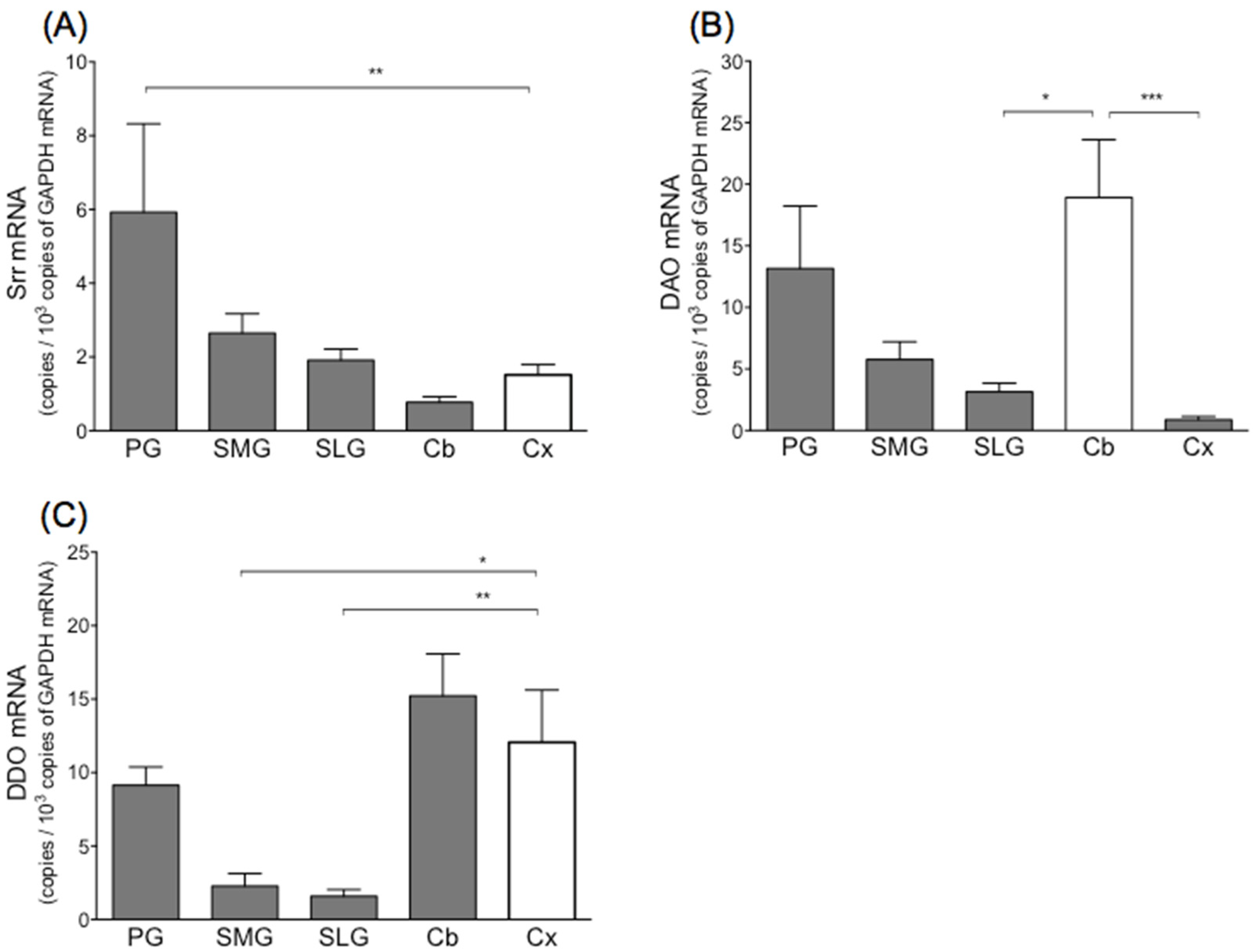
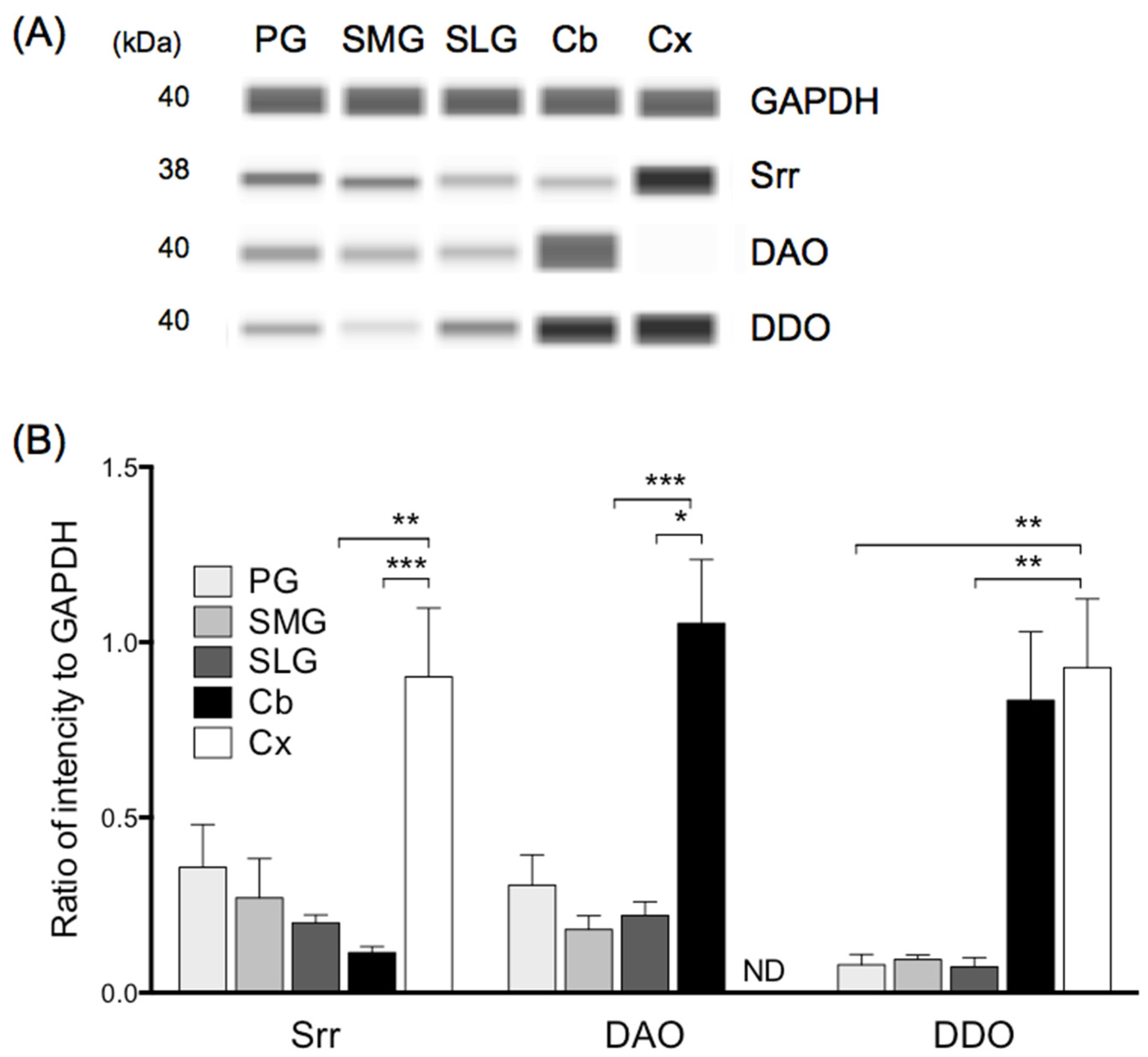
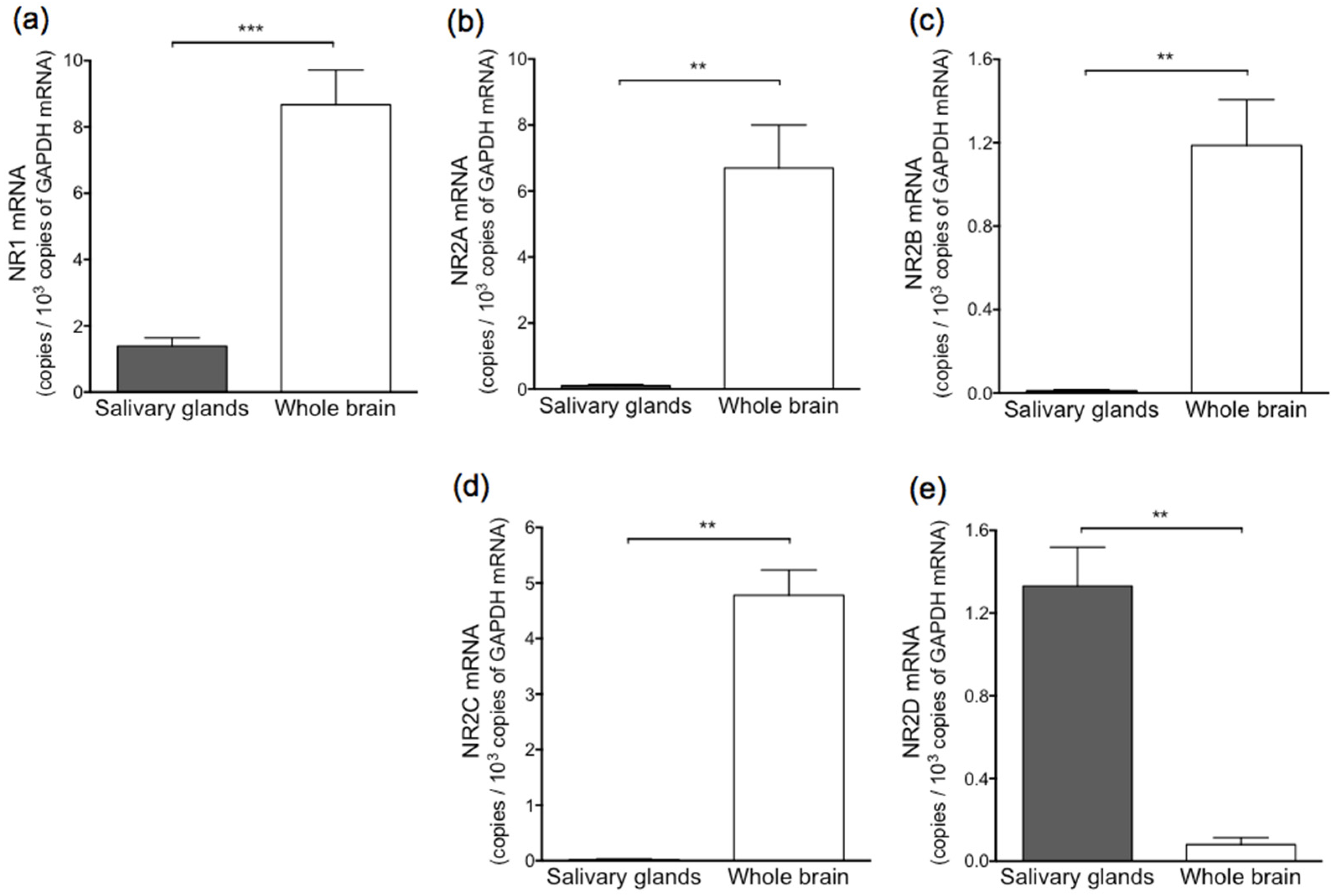
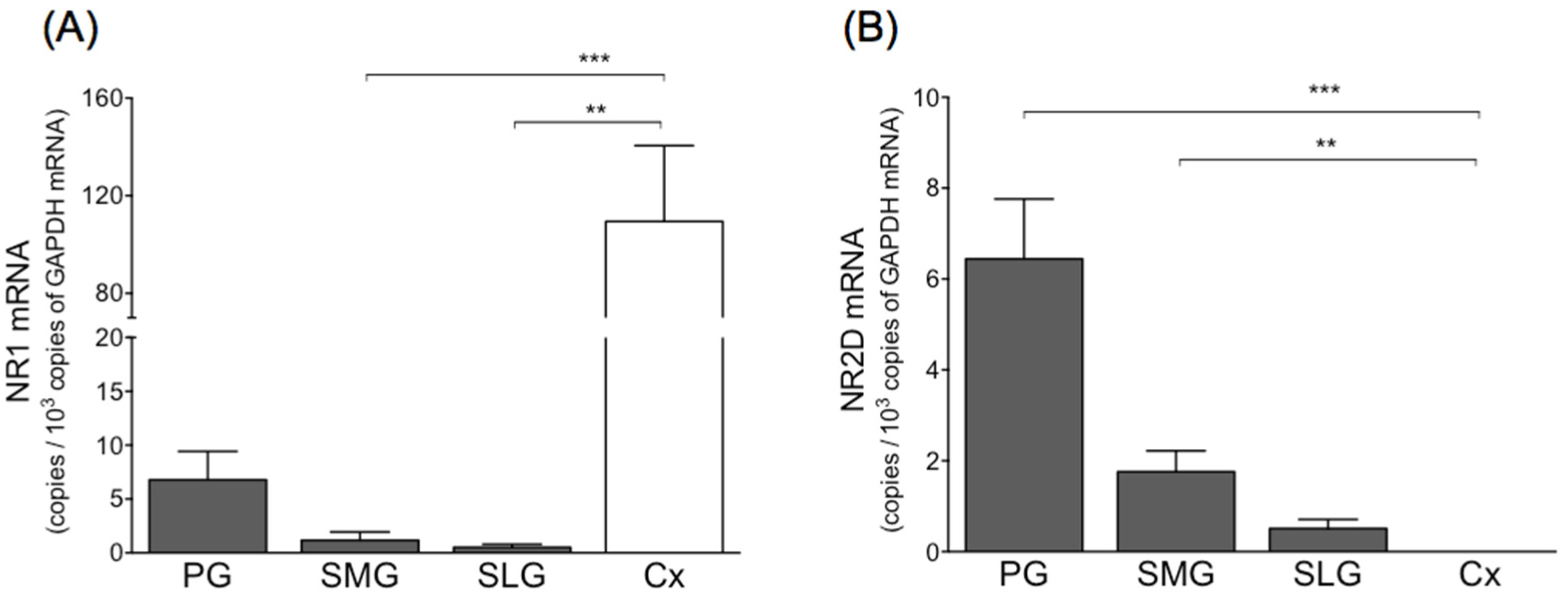
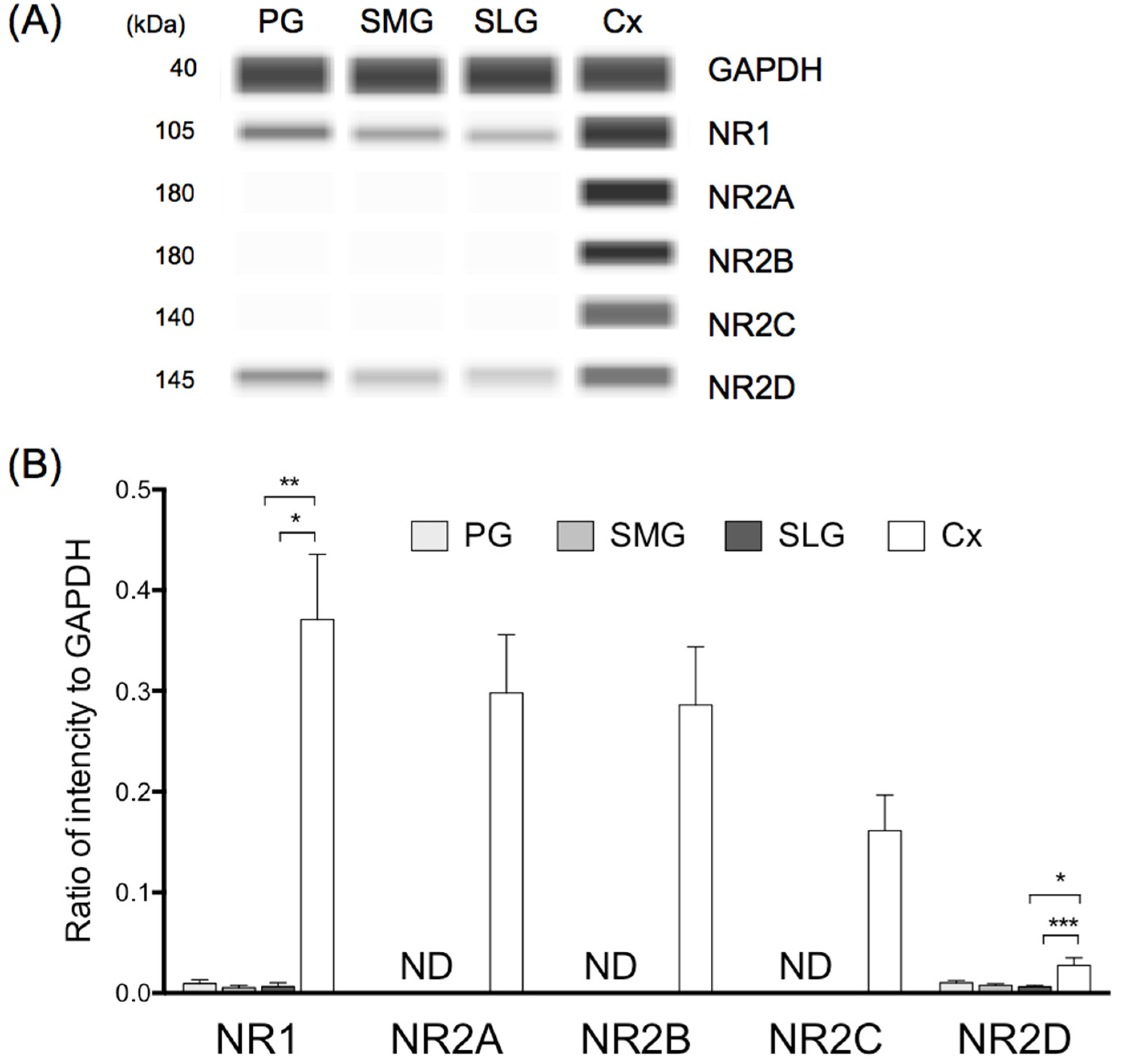
| Parotid Gland | Submandibular Gland | Sublingual Gland | |||||||
|---|---|---|---|---|---|---|---|---|---|
| D (nmol/g) | L (nmol/g) | D/(D + L) (%) | D (nmol/g) | L (nmol/g) | D/(D + L) (%) | D (nmol/g) | L (nmol/g) | D/(D + L) (%) | |
| His | N.D. | 406.2 ± 76.3 | – | N.D. | 751.8 ± 110.8 | – | N.D. | 582.3 ± 86.3 | – |
| Asn | N.D. | 480.0 ± 79.2 | – | N.D. | 998.0 ± 137.4 | – | N.D. | 997.6 ± 47.4 | – |
| Ser | 3.8 ± 0.5 | 1841.3 ± 199.4 | 0.2 ± 0.05 | 4.9 ± 0.5 | 3530.4 ± 246.2 | 0.1 ± 0.02 | 4.3 ± 0.3 | 3116.1 ± 164.6 | 0.1 ± 0.01 |
| Gln | N.D. | 1959.4 ± 221.0 | – | N.D. | 3603.8 ± 368.0 | – | N.D. | 3068.8 ± 320.9 | – |
| Arg | trace | 309.6 ± 99.1 | – | trace | 4547.1 ± 1321.9 | – | trace | 2678.5 ± 689.1 | – |
| Asp | 143.4 ± 65.7 | 786.0 ± 97.1 | 15.5 ± 7.4 | 174.3 ± 53.8 | 1381.9 ± 163.9 | 11.1 ± 3.1 | 104.7 ± 24.8 | 1833.4 ± 134.3 | 5.3 ± 1.0 |
| Gly | – | 3538.3 ± 614.8 | – | – | 4483.4 ± 440.2 | – | – | 4450.3 ± 243.9 | – |
| allo-thr | N.D. | N.D. | – | N.D. | N.D. | – | N.D. | N.D. | – |
| Glu | trace | 3670.2 ± 431.2 | – | trace | 3933.5 ± 319.9 | – | trace | 4625.5 ± 379.2 | – |
| Thr | N.D. | 837.9 ± 64.1 | – | N.D. | 1644.3 ± 171.31 | – | N.D. | 1564.0 ± 121.91 | – |
| Ala | 11.6 ± 8.8 | 3285.3 ± 461.3 | 0.3 ± 0.2 | 14.1 ± 8.1 | 6405.0 ± 531.9 | 0.2 ± 0.1 | 13.0 ± 7.9 | 5680.3 ± 151.5 | 0.2 ± 0.1 |
| Pro | N.D. | 1131.4 ± 44.1 | – | N.D. | 2641.7 ± 308.0 | – | N.D. | 2080.6 ± 178.5 | – |
| Met | N.D. | 262.8 ± 19.8 | – | N.D. | 742.5 ± 118.4 | – | N.D. | 644.5 ± 75.6 | – |
| Val | N.D. | 906 ± 180.7 | – | N.D. | 1845.6 ± 316.5 | – | N.D. | 1644.0 ± 206.6 | – |
| allo-Ile | N.D. | N.D. | – | N.D. | N.D. | – | N.D. | N.D. | – |
| Ile | N.D. | 363.1 ± 15.3 | – | N.D. | 1641.5 ± 361.5 | – | N.D. | 1266.6 ± 249.0 | – |
| Leu | N.D. | 1686.4 ± 303.8 | – | N.D. | 4093.9 ± 494.8 | – | N.D. | 3037.6 ± 376.20 | – |
| Phe | N.D. | 791.4 ± 142.2 | – | N.D. | 2205.2 ± 542.4 | – | N.D. | 1600.6 ± 355.3 | – |
| Trp | N.D. | 236.5 ± 40.6 | – | N.D. | 261.1 ± 40.4 | – | N.D. | 222.9 ± 11.4 | – |
| Lys | N.D. | 1153.9 ± 92.1 | – | N.D. | 2197.2 ± 413.0 | – | N.D. | 2263.1 ± 231.4 | – |
| Cystein | N.D. | 84.9 ± 70.1 | – | N.D. | 17.2 ± 11.2 | – | N.D. | 96.5 ± 26.4 | – |
| Tyr | N.D. | 303.0 ± 64.7 | – | N.D. | 877.9 ± 449.9 | – | N.D. | 3597.1 ± 514.6 | – |
Publisher’s Note: MDPI stays neutral with regard to jurisdictional claims in published maps and institutional affiliations. |
© 2022 by the authors. Licensee MDPI, Basel, Switzerland. This article is an open access article distributed under the terms and conditions of the Creative Commons Attribution (CC BY) license (https://creativecommons.org/licenses/by/4.0/).
Share and Cite
Yoshikawa, M.; Kan, T.; Shirose, K.; Watanabe, M.; Matsuda, M.; Ito, K.; Kawaguchi, M. Free d-Amino Acids in Salivary Gland in Rat. Biology 2022, 11, 390. https://doi.org/10.3390/biology11030390
Yoshikawa M, Kan T, Shirose K, Watanabe M, Matsuda M, Ito K, Kawaguchi M. Free d-Amino Acids in Salivary Gland in Rat. Biology. 2022; 11(3):390. https://doi.org/10.3390/biology11030390
Chicago/Turabian StyleYoshikawa, Masanobu, Takugi Kan, Kosuke Shirose, Mariko Watanabe, Mitsumasa Matsuda, Kenji Ito, and Mitsuru Kawaguchi. 2022. "Free d-Amino Acids in Salivary Gland in Rat" Biology 11, no. 3: 390. https://doi.org/10.3390/biology11030390
APA StyleYoshikawa, M., Kan, T., Shirose, K., Watanabe, M., Matsuda, M., Ito, K., & Kawaguchi, M. (2022). Free d-Amino Acids in Salivary Gland in Rat. Biology, 11(3), 390. https://doi.org/10.3390/biology11030390





